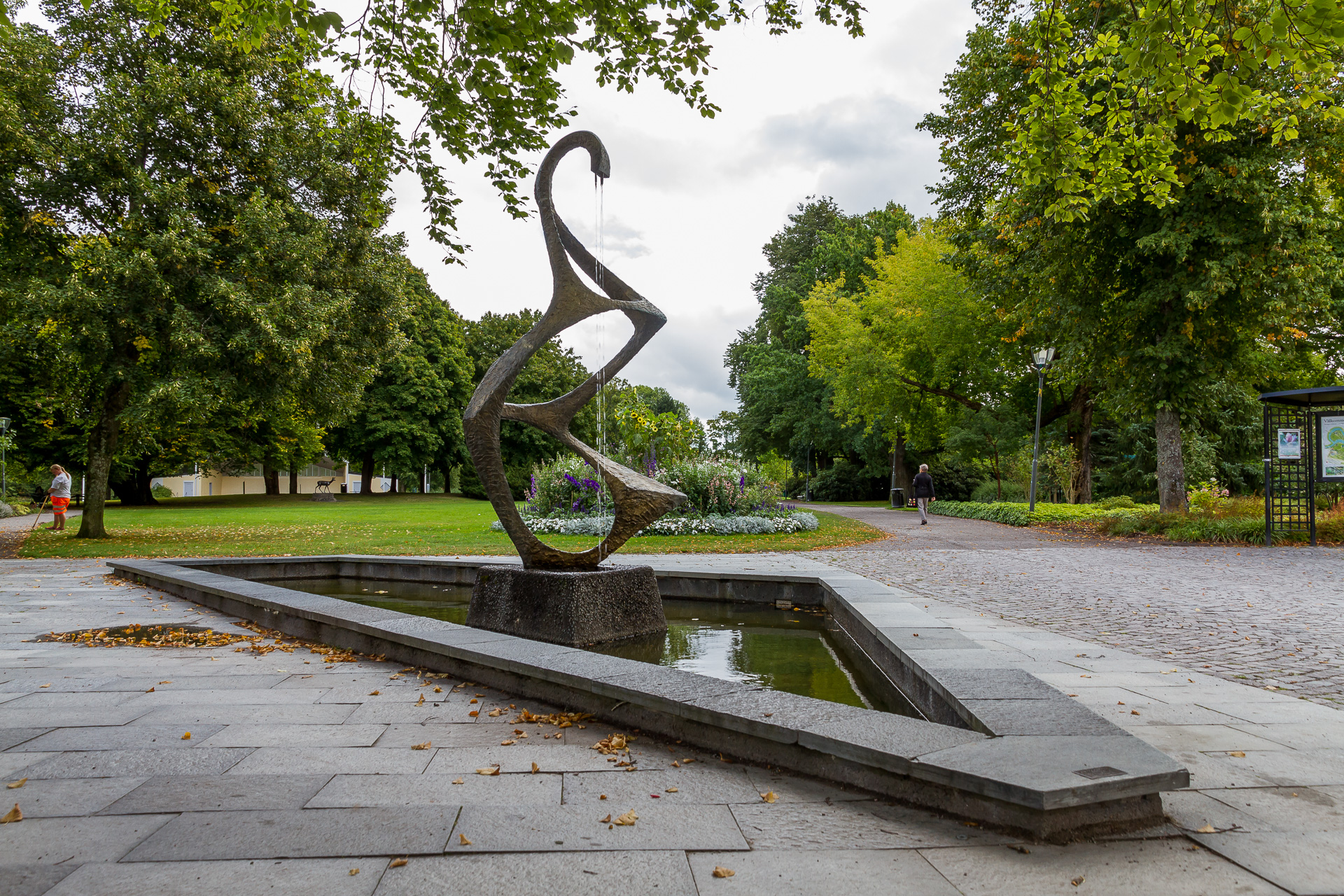Resonans (Resonance)
At Stadsparken's entrance, we are met by an abstract bronze sculpture on a low stone plinth in a pond. The sculpture is fully cast, but hollow. It strives upwards and can be said to be divided into three sections that could be described as two circles and a triangle. The lower part is a circular shape that balances on a high edge and tilts slightly backwards. It is built on with the next circle leaning slightly forward.
From two points on this upper circle, two rods now protrude that radiate together in the upside-down hook that is the sculpture's highest point. Water sprinkles down from the end of the hook through the circular shapes.

Arne Jones’s Resonance rises three and a half metres high from its pool at the entrance to Stadsparken, and through the hollow body of the sculpture, water trickles down in three pillars. The shape may be seen to resemble the strings running down over a double bass.
Similar to how the empty space in a bass creates resonance and amplifies the tones from the instrument’s vibrating strings, the empty space between and next to the sculpture’s thin curves provides space for the rhythmic reverberations of the shapes. Arne Jones made great use of voids and gaps in his sculptures, and many of his works from the 1950s and 60s testify to his play with empty space.
Jones lived from 1914 to 1974 and is usually counted among the so-called concretists. His name is often also mentioned in connection with the “1947 men”, a reference to the group exhibition held at Galleri Färg och Form in Stockholm in 1947 with artists such as Lennart Rodhe and Karl Axel Pehrson. There was also one woman among the men – Randi Fisher.
This exhibition is often seen as a breakthrough for a new generation of artists who wanted to focus on the concrete colour and shape of art rather than its possible illusory effects. Jones did not participate in the group exhibition but was part of the same innovative circle of artists.
Some representatives of concretism, or Art Conret as the art movement was called in French, absolutely refused to work figuratively. This reluctance does not seem to have existed in Jones, though, who instead became known for a quite honed capacity for abstract thought. A common denominator for concrete art was, however, that things such as space, rhythm and materiality were considered more important than art’s ability to depict or represent.
This exploration of the concrete form is evident in a work such as Resonance. Try walking around the sculpture to see how the different shapes stand out in sharp relief depending on where you stand.
Konstverk: Resonans (Resonance)
Konstnär: Arne Jones
År: 1958
Material: Bronze
Placering: Main entrance to Stadsparken
Ägare: Örebro läns Trädgårdsaktiebolag
Konstverkets position på karta
Publicerad:
Tack för ditt svar!
Berätta gärna vad vi kan göra bättre på den här sidan för att förbättra webbplatsen! Vi har ingen möjlighet att svara, men dina synpunkter är värdefulla för oss. Tänk på att inte skicka in personuppgifter. Om du vill ha svar på en fråga kan du istället använda formuläret ”Lämna en synpunkt”.
Om du ändå skickar in personuppgifter via detta formulär hanteras uppgifterna av Kommunstyrelsen och kan eventuellt lämnas vidare till annan verksamhet inom Örebro kommun i syfte att förbättra vår service.
Här hittar du mer information om hur vi hanterar personuppgifter.
Tack för ditt svar!
Du har nu hjälpt oss att förbättra orebro.se
